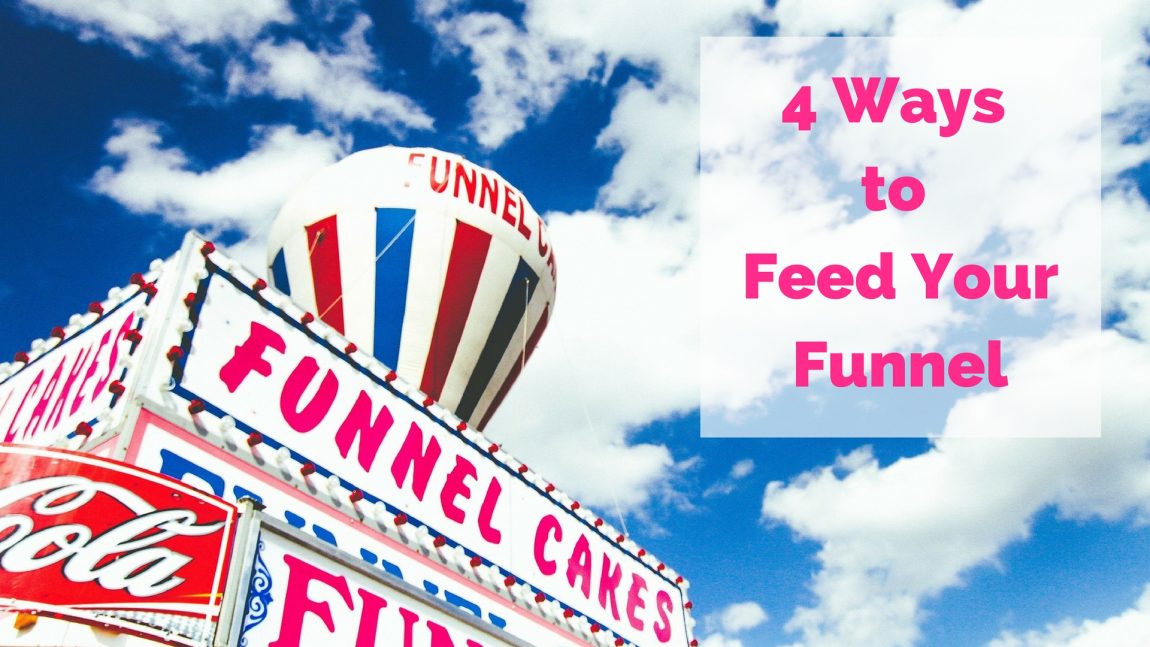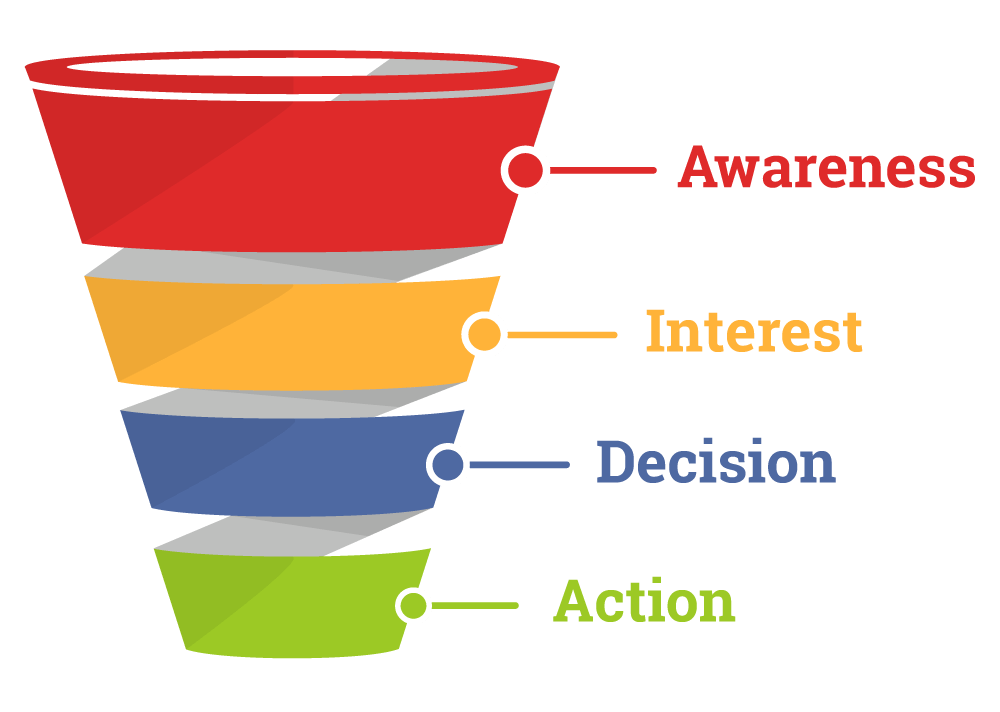4 Ways to Feed Your B2B Sales Funnel in 2018
by Emily Swet
Few things are worse for B2B business growth than a stalled out sales funnel. Even though your company may be using the same funnel-feeding tactics as before, what once worked may not be as successful now. To keep it going strong, we’ve compiled four ways to feed your B2B sales funnel in 2018.
1. Align Sales and Marketing Teams
Sometimes sales and marketing teams clash, despite having the same end goal. And this misalignment can lead to staggering losses. To get everyone on the same page, start facilitating communication between the two groups. Ask marketing to sit in on sales calls. Encourage sales to share their customer details with marketing. And encourage uniformity with constant updates between both departments. (Get more tips on sales and marketing collaboration here).
2. Consider Predictive Lead Scoring
Predictive lead scoring is a scoring methodology that leverages historical data and predictive analytics. It takes the data from successful leads (ones that you have won) and adds digital footprints from third-party sources to pool as much data as possible. By crunching the numbers, predictive lead scoring can identify patterns or relationships you’ve never seen before. It also aids in aligning your sales and marketing teams (see above) by providing data-backed reasoning behind lead qualifications. And last but not least, it reduces the margin of error in traditional lead scoring.
3. Don’t Forget the Mid-Funnel
Most marketing and sales teams focus on the top (lead quantity) and the bottom (the percentage of leads closed) of the sales funnel. However, when the middle is unattended to, the information and goals get murky. You could be losing leads without knowing why. To clear this up, ask: how many touches does the average lead need before they move to the next stage? Where do your leads seem to leak out? What is the difference between the ones that leave and the ones that move on? Diagnosing and addressing the issues mid-funnel will have a big impact on your results.
4. Use Video
We’ve made it clear in past blogs how important video has become. You can use it throughout your funnel to keep moving prospects to the bottom. To attract leads at the top, consider how-to’s, thought leadership videos, and any content that showcases your brand’s personality or authenticity. As your leads move to decision mode, product demos, client testimonials, and video case studies can be very compelling. Close the deal with nurture videos, FAQ’s, and instructional videos – and be sure each has a strong CTA (like signing up for a demo or webinar).
No matter what, it’s essential to keep the customer at the center of each stage. Every small fix you can make will help produce better results, and help grow your leads as well as your revenue.
Continue Reading
The Right Creative Media Mix to Feed Your B2B Sales Funnel
by MGB2B
With so many advertising options out there, it can be difficult to sift through the clutter and decide what the right B2B media mix is for your business. A media mix is the combination of communication channels you can use to market your business. It can include print and online ads, radio, television, billboards, websites, email, and social media. The mix will vary depending on your specific marketing goals; however, there is always one commonality: we want the consumer to take action.
That action could be visiting a landing page, filling out a contact form, or making a purchase. Whatever the desired action may be, the goal of your marketing mix is to drive as many customers as possible to that action. How? By feeding each step of the sales funnel with the right media tools.
Step 1: Awareness
What It Is – The customer is aware of the existence of your product or service, but doesn’t know much about it. Yet.
Media Tools – Broad reach media such as print ads in trade publications, radio, and television ads on targeted channels.
Step 2: Interest
What It Is – The customer begins actively expressing an interest in your product or service, but may still be skeptical.
Media Tools – Targeted, informational media such as paid social media posts with industry-related topics, informational webinars with affiliate trade publications, sponsored e-blasts through trade publications, paid search.
Step 3: Decision
What It Is – The customer is interested, engaged, and ready to make their decision. The goal is to make sure it’s you they are choosing.
Media Tools – Targeted, sales-focused media such as direct email campaigns, paid social media, targeted online display advertising, paid search.
Step 4: Action
What It Is – The customer is ready to take the next step towards purchasing your product.
Media Tools – Continuation of media from Step 3, with renewed focus on driving customers to your point of sale (website, contact form, phone number, etc.).
There is no absolute formula for making a sale. But by putting together an enticing media mix instead of putting your eggs all in one basket, you can guide your potential customer through the sales funnel – and increase your likelihood of closing that sale.
Having trouble getting started? We’re here to help!
Continue ReadingB2B Myth of the Week: Sales Collateral Is No Longer Important
by MGB2B
The Myth: Sales Collateral is No Longer Important
The Truth: High-Quality, Tangible B2B Sales Collateral Can Leave a Lasting Impression on Clients
With all the buzz around online content, it’s easy to think sales collateral is no longer important. But consider this: there’s tons of technical information to share with clients. We can’t expect them to remember it all. That’s where sales collateral comes in. It serves as a tangible reminder of the benefits or your products or services. And it simplifies the sales experience so you can close deals. If that’s not enough, here’s four more reasons why well-executed sales collateral is an important part of your marketing arsenal.
4 Reasons B2B Sales Collateral Is Still Important
- It Communicates Important Information Succinctly. It’s unlikely that your leads will remember everything you tell them in a meeting. Having information laid out in simple terms all in one place makes it easy to both digest and remember. And while having that information online is important, a brochure is something prospects can keep on their desk to remind themselves of your brand when making a purchase decision.
- It Can Showcase Your Credibility. Rather than wait for your leads to seek out your case studies, hand them over directly. Seeing your success displayed in a quality document offers proof, reinforces your reputation, and is easily shared with other decision-makers.
- It Adds to Your Brand Story. While it may be tempting to put all of your information online, your personality comes to life more so in a printed piece. The weight of the paper, the feel of it, the gloss or matte finish, all give your brand story more depth. In addition to creating consistency and credibility across your brand, it rounds out the personality you’ve created online and in your offices. From business cards to brochures to sell sheets, your collateral has the potential to strengthen your company’s image – so long as you create a high-quality experience.
- It Can Close the Deal. According to Forbes, buyers go 70% of the way through the decision-making process before engaging with a sales representative. So if a buyer is more than halfway there when you meet, imagine leaving them with a high-end, well-designed, well-produced, and authoritative booklet or sell sheet. Since many companies are funneling their money into digital efforts, it could be the point of differentiation that seals the deal.
It’s easy to overlook printed collateral in today’s digital-first world. But that’s even more reason to make your sales materials stand out. Need help with the execution? Give us a call.
Continue Reading
